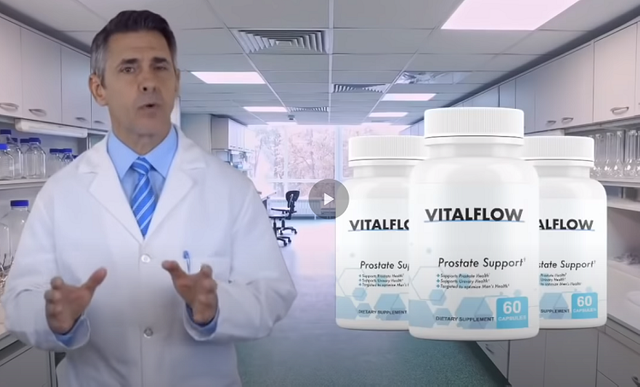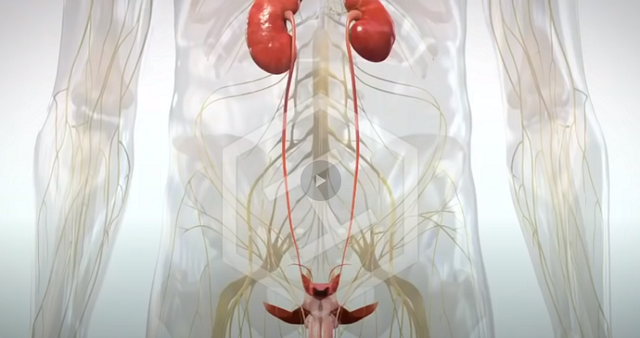VitalFlow prostate supplement ingredients, reviews, supplement, (does vitalflow work?)
Reviews of Vital Flow Users
Rolando M.
I've had prostate problems for a long time. While researching on the Internet, I saw and bought VitalFlow. As a result of regular use, you definitely feel its positive effects. Be patient and get healthy with VitalFlow.
>> Click Here To Get Vital Flow <<
William G.
I felt like burning in urine and never finished. I went to the doctor and said there was an enlarged prostate. He gave me drugs, but he did not work. Then I discovered VitalFlow. I used it regularly and after 1 month I had no complaints anymore. Thanks to VitalFlow, prostate enlargement stopped and healed. I would recommend it to everyone.
>>WitalFlow Visit The Official Website<<
Donnell S.
I went to the doctor last year and found out that I had chronic prostate disease. I used various antibiotics and other medications. None of them worked, my prostate complaints did not pass. I bought VitalFlow on the advice of my friend. I really got better as a result of regular use. Now I have no troubles and I am very comfortable.
>> Click Here To Get Vital Flow <<
John T.
When I found out that I had prostate disease, I tried many methods to heal. I drank parsley juice for a long time, but that didn't work either. While researching, I found VitalFlow. As a result of regular use, it had a healing effect on the prostate. So I bought VitalFlow and started using it. Indeed, all my complaints completely disappeared within a month. I'm very comfortable now.
>> WitalFlow Visit The Official Website
Charles K.
Prostate inflammation is a disease that can occur in everyone young and old. I am 26 years old but have prostate inflammation. The doctor gave medication, I used medication for a long time, but it did not work, my pains did not go away. My father suggested VitalFlow. I thought it was useless, but after I started using it, all my pain passed. Now I am much better thanks to VitalFlow.
>> Click Here To Get Vital Flow <<
Lanny H.
When I went to the toilet very often, I thought there was a problem and went to the doctor. At the same time, there was burning while peeing. The doctor said that he had prostate inflammation. He told me to use antibiotics and some drugs. I used it for 3 months, but it had no effect. I recently bought VitalFlow. Shortly after I started using it, my complaints started to decrease. VitalFlow really worked. I am very satisfied and recommend it to everyone.
>> Click Here to Order Vital Flow From Its Official Website Now <<
Richard
L.
When I went to the doctor, he said he had prostatitis. It was the first time I heard in my life. I started using the medication recommended by the doctor. But my pains did not go away, I still had pains. I saw and bought it on VitalFlow's website. I still keep using it now. Thanks to VitalFlow, pain and burning sensations have passed. I'm much better.
Barton E.
I am a 30 year old married man. I was going to the toilet very often and there was burning. I went to the doctor, he said it was a prostate. The prostate was very large and inflamed. He said that if he progresses further, the prostate will be removed. If I had a prostate, I wouldn't have any children. Of course I did not want this either. While researching I found VitalFlow and bought it immediately. After using it for 1 month, my pains started to go away. I went to the doctor again and the tests were done. Prostate inflammation had completely disappeared. Thanks to VitalFlow, I got rid of surgery. It is really a very successful product.
>> WitalFlow Visit The Official Website
Chris S.
I started to feel burning and stinging on the tip of the penis. It was the first time such a thing happened. I immediately went to the doctor and found out that he had prostatitis. Then there was burning and pain when peeing. I tried broccoli juice, parsley juice, but none of them worked. Shortly after using VitalFlow prostate supplement, the feeling of stinging and burning completely disappeared. After 1 month, I was completely cured. It's a very nice product.
General Information About Prostate
What is the prostate? What is benign prostate enlargement?
It is a gland of 18-20 grams, the main function of which is at the outlet of the prostate urine bag, which is related to reproduction. The prostate, which passes through the urination channel and grows in size in most men with aging, does not follow a similar path in every man when it exceeds their normal size. While some men grow into the urinary tract passing through the prostate, some men also grow into the bladder. In this type of enlargement, while the prostate appears slightly enlarged on the ultrasound images, the patient may have serious complaints. In cases where the prostate enlarges outward, although the prostate is very large, the patient does not have the same proportion of complaints.
VitalFlow Review Video
Why does the prostate grow?
In men, the prostate grows in early puberty (doubles). After 25 years old, the prostate grows in different ways for all men. The causes of prostate enlargement are still unknown today, and it is believed that male hormone (testosterone) and estrogen play a serious role in this growth.
In what age groups does the prostate grow?
The prostate gland begins to grow in men in their 30s and lasts until the end of life. While prostate enlargement is seen in half of men over 50 years of age, this rate rises to 65% after age 60. With the age of 80, the growth rate exceeds 90%. A significant portion of these patients are followed up by drug therapy or surgery.
Watch this video for the healing process with Vital Flow
How does prostate enlargement cause complaints?
The prostate gradually grows over the years and begins to squeeze the urinary tract passing through it. The urinary organ is a bladder and has a structure made of muscles. Although the prostate compresses the urinary canals, in response to this situation, the muscles of the urine bag expand and the urine bag begins to contract more strongly. At these stages, the patient may not have any complaints or complaints such as going to the toilet frequently due to excessive activity of the bladder, getting up to urinate at night, suddenly needing a toilet and running to the toilet quickly, and sometimes urinary incontinence. As time goes on, the prostate continues to grow and fatigue occurs in the bladder muscles. In this case, the urine flows of the patients slow down, forked voiding, dripping while urinating, intermittent urination, and after urinating, there is still a feeling of urine inside. In untreated patients, melting occurs in the bladder muscles, high pressure in the bladder begins to disrupt the kidneys. Even if treatment is taken after this stage, the urinary bladder and kidney functions are often not restored.
Is waking up at night and going to the toilet a sign of prostate enlargement?
One of the early signs of prostate enlargement is the need for toilet at night. When prostate enlargement causes difficulty urinating, patients often go to the toilet at night and this need continues during the day. The most important reasons for going to the toilet at night are diabetes, cardiovascular diseases. Apart from this, with the aging, the secretion of “anti diuretic hormone” from the brain pituitary gland decreases at night and the amount of urine produced at night increases. The patient who complains of going to the bathroom at night should be examined in detail. Men who go to the toilet frequently at night for non-prostate reasons may not benefit from going to the toilet frequently at night, even if they receive prostate enlargement treatment or surgery.
>> Watch this video for the healing process with Vital Flow <<
How is benign prostatic enlargement diagnosed?
Diagnosis of prostate enlargement is made with blood and urine tests, tests and tests that will not disturb the patient in any way, such as ultrasonography and urine flow test. The treatment plan is applied according to the degree of growth detected in the person and the complaints created by the patient.
How is the treatment of benign prostatic enlargement planned?
Benign prostatic enlargement is treated with lifestyle changes, patient monitoring, medication and surgery. Since the prostate is an organ that grows with age in the natural process, it is not possible to prevent this. However, in this period, treatments are applied that minimize the patient's complaints and improve the quality of life.
What are the prostate enlargement treatment steps?
Approaches are applied to eliminate the patient's urination complaints. The patient is not offered surgery immediately, and a course of treatment is followed based on complaints and their severity. Generally, firstly, arrangements are made for the patient's toilet habits and lifestyle. If necessary, drug treatment can be started as a second step.
How can he make adjustments in lifestyle to reduce the patient's complaints in prostate enlargement?
Prostate patients should first avoid alcohol and caffeine-containing beverages that will increase the amount of urine. If the prostate patient travels during the day and complains of going to the toilet frequently, limiting fluid intake during the day can be comforting for the patient. Usage times of drugs that affect the voiding (diuretics, etc.) should be arranged according to the patient's complaints. Apart from this, urinating 2 times in a row may reduce the complaints of patients. Prostate patients are recommended to take measures against constipation and establish their diet accordingly.
Vital Flow Review: Click for Video
Treatment process is planned for patients who need to use medication?
Drugs used today do not have a curative effect on prostate enlargement. Drug treatment in prostate enlargement is applied to reduce patients' complaints. They are the drugs called “alpha blockers” that are used most frequently as medication and relieve the prostate occlusion in the fastest way . In recent years, these drugs have very low types of side effects. In addition, there is a group called “ 5 alpha reductase inhibitors ” that stop the growth of the prostate and decrease in size in patients with a prostate size over 35 grams . The effectiveness of these drugs begins after 9 months after regular use. If the patient often goes to the toilet and is diagnosed with overactive bladder, then“Anti-cholinergic group ” drugs are added. In recent years, it has been proved that the drugs " Phosphodiesterase 5 inhibitor " groupeffective on hardeningregulate voiding complaints in regular use. There are also special medicines for patients who often wake up to go to sleep at night.
What medicines can patients and prostate medicines not take together?
“Alpha blocker” drugs used for prostate enlargement and some drugs that provide hardening should not be used together. This can cause serious blood pressure drops in patients. Some antibiotics, epilepsy drugs, some drugs used in psychiatry may interact with drugs used in prostate enlargement. Patients should definitely inform their doctor about the drugs they use for benign prostatic enlargement.
>> Watch this video for the healing process with Vital Flow <<
When is prostate surgery necessary?
If, despite drug treatments, the patient's voiding complaints continue, if there is severe bleeding in the urine due to recurrent urinary tract infections, or if the patient has had urine to be able to urinate, the need for surgery can be mentioned. Despite all these complaints, if the operation is delayed, bladder and kidney problems will arise, and the patient will face kidney failure.
What methods are prostate surgeries performed?
Operations for prostate enlargement can be grouped under 2 main headings. The first of these is the operations where the prostate is cut through the urethra and cut through the inside. The most well known is the TUR process. In TUR surgery, the growing part of the prostate is cut off using an electric wire at the tip of the instrument. Since the electrical energy used in classical TUR surgery may have a side effect on the erection functions, different energies called bipolar or plasminetic are used in TUR operations today and very successful results are obtained. There are also laser methods made by entering through the voiding channel and evaporating the prostate. Different energy sources such as greenlight or diode laser are used in these techniques. One can also mention the "Holmium enucleation" method for large prostates, in which the prostate is peeled like an orange peel. The second main topic is prostate enlargement surgeries performed through the abdomen. These are open prostatectomy, laparoscopic simple prostatectomy, and robotic simple prostatectomy surgeries. In addition to the prostate, the urine bag is cut in surgeries performed through the abdomen, and bleeding may be more than the surgeries performed through the urinary canal. Therefore, this type of surgery is not preferred unless it is necessary. In addition to the prostate, the urine bag is cut in the abdominal surgeries, and bleeding may be more than the surgeries entered through the urinary canal. Therefore, this type of surgery is not preferred unless it is necessary. In addition to the prostate, the urine bag is cut in surgeries performed through the abdomen, and bleeding may be more than the surgeries performed through the urinary canal. Therefore, this type of surgery is not preferred unless it is necessary.
Which surgeries are preferred for patient comfort in the treatment of benign prostate enlargement?
Prostate surgeries have features that shorten the patient's recovery time and provide life comfort thanks to new methods applied today. Patients with benign prostate enlargement problems are evaluated by urologists and the most appropriate form of surgery is planned for the patient. Prostate size is very important in some surgical methods. For example; Prostate up to 80 grams can be operated without any problem with many systems. If there is a situation that requires the patient to continue using blood-thinning medications during surgery, laser treatments should be considered in the foreground. If the patient cannot receive anesthesia (general or spinal), then surgeries that can be performed under local anesthesia should be preferred. In prostate surgeries, it is also important to which type of surgery the surgeon is experienced. For example, in TUR surgery, Experienced surgeon in this field can treat prostate up to 120 grams. Prostate surgeries called “plasmakinetik” come to the fore in patients with a prostate below 120 grams and who do not use blood thinners during surgery. If the patient uses blood thinners and the prostate is below 80 grams, it may be appropriate to evaporate the prostate with a greenlight laser. If the patient's prostate is more than 120 grams, the success of prostate enucleation surgery with Holmium laser is indisputable. If it is necessary to treat a disorder of the urinary bladder along with the prostate, then benefiting from robotic surgery provides successful results. Prostate surgeries called “plasmakinetik” come to the fore in patients with a prostate below 120 grams and who do not use blood thinners during surgery. If the patient uses blood thinners and the prostate is below 80 grams, it may be appropriate to evaporate the prostate with a greenlight laser. If the patient's prostate is more than 120 grams, the success of prostate enucleation surgery with Holmium laser is indisputable. If it is necessary to treat a disorder of the urinary bladder along with the prostate, then benefiting from robotic surgery provides successful results. Prostate surgeries called “plasmakinetik” come to the fore in patients with a prostate below 120 grams and who do not use blood thinners during surgery. If the patient uses blood thinners and the prostate is below 80 grams, it may be appropriate to evaporate the prostate with a greenlight laser. If the patient's prostate is more than 120 grams, the success of prostate enucleation surgery with Holmium laser is indisputable. If it is necessary to treat a disorder of the urinary bladder along with the prostate, then benefiting from robotic surgery provides successful results.
What are the complications that can be seen after prostate surgery?
Classically, bleeding is the most common complication seen after prostate surgery. During the operation, the prostate may not be adequately cleaned. If it is postoperative, the patient may have to undergo surgery. Apart from this, the development of stenosis in the urinary ducts after surgery is a rare complication but annoying complication for both the doctor and the patient. It is important to work with as thin instruments as possible and to maintain complete instruments to avoid urethral stenosis. It can be seen in infection in the urinary tract after surgery. Although there is a long list of complications in the literature ranging from prostate surgeries to bladder eruption, the risk of complications is minimal in prostate surgeries performed using modern tools in the hands of an experienced surgeon.
How are patients' sexual lives affected after prostate surgery?
If a patient's erection functions are normal before prostate surgery; Due to prostate enlargement, non-erectile dysfunction and success rate are 98-99% after modern surgeries (plasmachinetic TUR, greenlight laser, Holmium laser enucleation) performed by experienced urologists. The amount of semen thrown out often decreases after prostate surgeries. Because the prostate is scraped, some of the semen that comes out of the ovaries is thrown into the bladder and some is thrown out. This situation is important for the elderly father candidates who are considering children.
Can a patient with prostate surgery have children naturally?
In men who have surgery due to enlarged prostate, the amount of semen decreases because some of the semen will escape to the bladder during ejaculation. The possibility of the patient to have children in a normal way is reduced. However, although the patient cannot have children in the normal way, this problem can be eliminated with an easy technique such as vaccination. In the operations for prostate cancer, the semen canals and the glands that make up the semen are removed, so the patient can only have children with the IVF method.
What is the place of robotic methods in prostate surgery?
Robotic surgery has a very important place in prostate cancer surgeries. When the prostate is considered like an orange, in prostate cancer surgery, the orange is removed with its branches and leaves around it. In the prostate enlargement surgery, the fruit of the orange is removed; Everything, such as the orange's shells, branches, leaves, remains in place. Since the prostate and the surrounding glands are removed in prostate cancer surgery, it is necessary not to damage the nerves and structures that pass near the prostate and provide erection and urine retention. Since there is no bleeding in robotic surgery, every point is seen very well and technology provides the doctor with the opportunity to perform the surgery perfectly. Cancer tissues are cleared and incontinence occurs after surgery (after recovery) in almost all patients. The sexual lives of the majority of patients are also not adversely affected. However, it is not the robot that performs the surgery, but the surgeon. The surgeon performs the surgery using the robotic system. The knowledge, experience and ability of the surgeon are also very important for the success of the operation. Robotic surgery is not used unless necessary, since surgeries can be performed through the voiding hole in prostate enlargement. While robotic surgery provides excellent results in prostate cancer surgery, it is a limited method in prostate enlargement. The knowledge, experience and ability of the surgeon are also very important for the success of the operation. Robotic surgery is not used unless necessary, since surgeries can be performed through the voiding hole in prostate enlargement. While robotic surgery provides excellent results in prostate cancer surgery, it is a limited method in prostate enlargement. The knowledge, experience and ability of the surgeon are also very important for the success of the operation. Robotic surgery is not used unless necessary, since surgeries can be performed through the voiding hole in prostate enlargement. While robotic surgery provides excellent results in prostate cancer surgery, it is a limited method in prostate enlargement.
Can prostate cancer develop in a patient who has prostate surgery due to prostate enlargement?
Prostate enlargement surgeries are performed by removing the prostate. So the shell part is left.
What is the place of PSA test in blood in the diagnosis of prostate cancer?
PSA is a blood test that has been used in the diagnosis of prostate cancer for many years and is well known to everyone, but it is “well known”. Prostate-specific antigen (PSA) is a substance produced by certain cells in the male prostate gland. The PSA is secreted into the semen by the prostate, allowing liquefaction of the semen after ejaculation. It is used by doctors to identify patients at risk for prostate cancer. The fact that it is within normal limits does not indicate that the patient does not have prostate cancer, nor does it indicate that the patient has a high level of prostate cancer. It gives doctors signals that the patient is at risk for prostate cancer and that further investigation is required. Apart from prostate cancer, PSA can also increase as a result of benign prostatic enlargement and prostate inflammation. PSA normal values differ by age. In general, the limit value is given as <4>
How are MR assisted prostate biopsies performed in the diagnosis of prostate cancer?
In “standard prostate biopsy”, the prostate capsule part (peripheral zone) is divided into 12 regions and a random piece is taken from each region. The ultrasound device cannot separate normal prostate tissue and cancerous tissue, so suspicious areas cannot be targeted for biopsy. It is hoped that random samples will be taken from different areas of the prostate and tumor tissue will be encountered. These random biopsies sometimes cannot catch cancers with the potential to progress rapidly. In “new type of MR fusion biopsies”, a special prostate MRI is first taken to the patient. Afterwards, suspicious areas for prostate cancer are identified and marked in digital environment in MR. These images are loaded on special ultrasound devices and prostate biopsies are taken especially from the areas marked by MR. Especially 0 in MR prostate.



